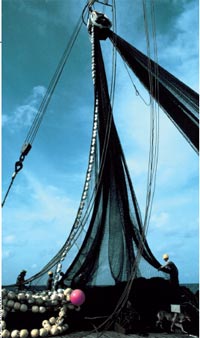Imperfect Storm
The dangers of commercial fishing run deep.
 Maybe you’ve seen the T-shirt: “A bad day of fishing is
better than a good day of work.” But what about
when a bad day of fishing is a bad day of work, as it is
for the estimated 38,000 men and women who fish
commercially in the United States? The Department of Labor is
uncertain of the actual number of those in the industry because of
the seasonal nature of the work and the fact that two out of three
are self-employed, but the department does know that the ranks
are dwindling, and it expects employment in the industry to ebb
further, rapidly. It also knows that even with fewer fishermen in the
workforce, the industry’s fatality rate is consistently among the
highest of all U.S. occupations. In 2006, it averaged nearly one
death each week.
Maybe you’ve seen the T-shirt: “A bad day of fishing is
better than a good day of work.” But what about
when a bad day of fishing is a bad day of work, as it is
for the estimated 38,000 men and women who fish
commercially in the United States? The Department of Labor is
uncertain of the actual number of those in the industry because of
the seasonal nature of the work and the fact that two out of three
are self-employed, but the department does know that the ranks
are dwindling, and it expects employment in the industry to ebb
further, rapidly. It also knows that even with fewer fishermen in the
workforce, the industry’s fatality rate is consistently among the
highest of all U.S. occupations. In 2006, it averaged nearly one
death each week.
Among the ever-present perils commercial fishing crews face are
the heavy equipment with moving parts used in all kinds of weather,
some of it making for seriously unstable environments, and slippery
decks that can lead to serious injuries or falling overboard.
Drowning due to the loss of a vessel is the industry’s leading cause
of fatality. Powerful winches, cables, ropes, nets, and
other gear can malfunction and either cut or entangle
workers, swinging blocks can hit them in the
head, and rogue waves can pack a punch, sometimes
leaving workers asea. Often the work involves long,
erratic hours, sometimes over the course of weeks,
making sleep deprivation an issue, and jobs can take
place hundreds of miles from shore with no help
readily available.
“Just think of a large logging crane, and now
imagine that crane being on a rocking boat, and that’s
what handling fishing gear is like,” says Doug Gregory,
a Sea Grant extension agent based in Monroe
County with the University of Florida. “You’ve got all
this tension on the cables or rope, and then you’ve got
the boat and the equipment rocking back and forth,
jumping up and down, depending on the weather. It’s
tremendous strain on the systems.”
Risk Pool
Even with all the ambient hazards, though, Gregory notes that the
industry’s high fatality statistics represent the national picture and
don’t necessarily tell the whole story. In general, the Pacific Ocean
is rougher than the Atlantic, and, examined regionally, the Pacific
northwest and Alaska coasts annually claim the most lives. The
Discovery Channel’s “Deadliest Catch,” which documents crab
fishing off the Alaska Peninsula in the Bering Sea, depicts “an extreme,”
he adds, by way of example. “If they tried to do a TV show
about lobster fishing in the Florida Keys, everybody would say
‘ho-hum.’We have relatively mild weather down here, except
when we have a hurricane.”
Mike Plotnick, a research analyst with the Alaska Department
of Fish & Game, says that while the industry in his state does routinely
offer high
drama, even king
crab fishers are
sometimes forced
to wait out bad
weather. “Commercial
fishing in
Alaska is work in
one of the world’s
harshest environments,”
he says.
“Cold water and
icing on the vessels
make it a long
day. Issues such as
fatigue and physical
stress are normal and always there. Usually, there’s also financial
pressure to go out there.”
Angling for Safety
According to Gregory, it was the sinking of an
Alaskan crab boat and the ensuing investigation
that led, two decades ago, to the industry’s first law
aimed at improving its safety record. Passed by
Congress in 1988, the Commercial Fishing Industry
Vessel Safety Act requires boats to carry life
rafts, survival suits, fire extinguishers, alerting and
locating equipment, and other gear designed to
improve survivability in the event of an accident.
U.S. Coast Guard officials, the Act’s primary enforcers,
say it has definitely helped. In Alaska,
USCG implemented the Dockside Enforcement
Program in 1999, which further decreased the
state’s leading fatality statistics.
Jack Giard, president of the Washington Reef Net
Owners Association, has commercially fished the
waters off Lopez Island in the Puget Sound since 1958 and been an
active participant in the industry’s evolution. “When I first started,
it was a pretty primitive fishery,” he says. “We didn’t have electric
winches.We didn’t have a lot of things on there that would cause a
boat to go right to the bottom.”
Federal fleet-reduction programs, heavy regulation on catches,
and high business costs in general have contributed to shrinking
the commercial fishing workforce, but the industry remains a dynamic
and important one for the nation, as Giard notes. “There
are not too many guys who can afford to stay in it, which is too
bad because we love what we do and it’s unique in the world—
there’s no other thing like it,” he says.
This article originally appeared in the June 2008 issue of Occupational Health & Safety.